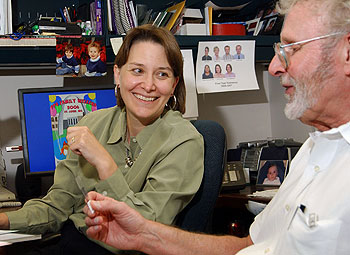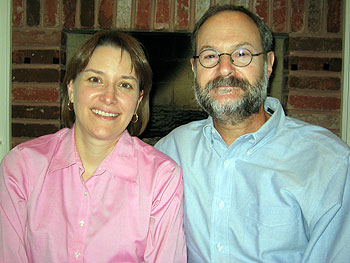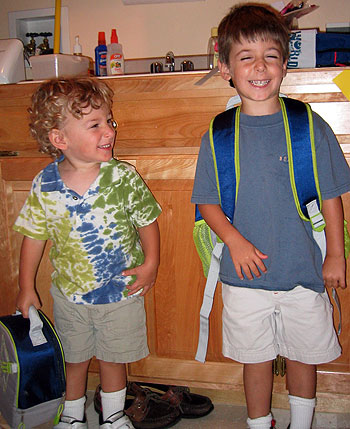As a medical student, Ashley Hill’s start in her future specialty, pathology, came late. She didn’t take a pathology course until her fourth year of medical school. One of her course assignments, though, was to lead an autopsy under the supervision of a pathology resident. The patient, who was middle-aged, had suddenly developed breathing difficulty and died.

The patient had been suffering from several different conditions, but the final cause of death was determined to be a blood clot. As Hill was removing and weighing the patient’s organs, though, she noticed something puzzling: they were unusually large and heavy.
A short time later, as Hill was determining where she wanted to apply for residency, she interviewed with WUSTL’s Marc R. Hammerman, M.D., the Chromalloy Professor of Renal Diseases in Medicine. During the course of the conversation, Hill and Hammerman realized that they are both from southern Illinois.
This led Hammerman to bring up another native of southern Illinois, Robert Wadlow, who is listed in the Guinness Book of World Records as the world’s tallest man (8 feet 11.1 inches). Hammerman, who trained as an endocrinologist, had studied Wadlow’s case records because his excessive height stemmed from a condition known as gigantism or acromegaly, which results from oversecretion of growth hormone from the pituitary gland.
“Dr. Hammerman mentioned that the organs can get really big in patients with too much growth hormone,” Hill remembers. “And as soon as the interview was over, I ran back to pathology and pulled out slides of the pituitary from that autopsy.”
Physicians had tested for the possibility of acromegaly earlier, screening the patient’s blood for elevated levels of growth hormone. However, the patient’s kidneys were failing at the same time. This allowed the hormone to slip from the blood into the urine, and the test came back negative as a result.
When she looked at slides of the patient’s pituitary gland, though, Hill was able to see signs of a tumor in the pituitary that probably caused oversecretion of growth hormone. Hill presented her findings at the clinical pathologic conference, with an introduction from Hammerman, and she was on her way to being hooked on pathology.

“The really great thing about being a pathologist is that we get to sit around and think about stuff,” Hill says with a grin.
Now that she’s earned a medical degree and is an assistant professor of pathology, Hill has set her sights on a bigger mystery involving many patients. With the help of several colleagues, she is hunting for the genetic mutations that lie at the heart of a rare childhood lung tumor, pleuropulmonary blastoma (PPB). The condition originally was identified in the 1970s and 1980s by Hill’s mentor in pathology, Louis P. “Pepper” Dehner, M.D., professor of pathology and immunology and of pathology in pediatrics.
About half of the children affected by PPB do not survive. The condition leads to formation of lung tumors in the first five years of life and also can cause brain cancer and other tumors. Early diagnosis and aggressive treatment, unfortunately still relatively rare, improves chances of survival up to 80 to 90 percent.
Scientists have discerned a tangled pattern of connections between PPB and other types of cancers. There seems to be an unusually high frequency of other tumors afflicting PPB patients’ siblings and other relatives. Like PPB, many of these tumors appear to have something to do with organ development.
“PPB sits at the crux of a group of childhood tumors that include rhabdomyosarcoma, Wilms’ tumor and neuroblastoma,” Hill notes. “So the hope is that if we can learn more about the origins of PPB, we will not only have the potential for better diagnosis and treatment of PPB, we may also shed some light on these much more common tumors of childhood.”
Finding the mutations that cause PPB is sure to be challenging: PPB is a rare condition, with only 300 cases in the past 16 years, and about 15 new diagnoses each year. Many of those patients are enrolled in a registry, but to effectively seek the genetic roots of PPB, scientists needed to assemble a much more detailed collection of information not just on patients but on their extended family members as well.

Additionally, an initial look at DNA from patient tumors had shown irregularities in chromosome structure and extra chromosomes. But those irregularities varied extensively from patient to patient. Many patient tumors have three copies of chromosome 8, but so far that is the only abnormality that has shown up with any consistency.
Hill says she “worked very hard from a public relations perspective” to recruit her multidisciplinary team of collaborators, which includes researchers from several disciplines at WUSTL and two oncologists from the University of Minnesota, where a particularly large family has been affected by PPB more than once.
“I had to tell everyone, yes, PPB is rare, yes, it will be difficult, but I know we can do this,” Hill remembers. “When mustering your own resolve and that of others, it helps to be a little naive of the enormity of the task you’re taking on.”
Former mentor Dehner credits Hill’s successful assembly of a research team to two other qualities: leadership and tenacity.
“When she takes a task on, it’s going to get completed,” Dehner says. “We’re all looking forward to the day when we can report on what the molecular abnormalities underlying PPB are, and Ashley can take an enormous amount of credit for it.”
Hill’s voice still has a faint twang from her years growing up in southern Illinois. She completed medical school, an internship in internal medicine, a pathology residency and a pediatric pathology fellowship at WUSTL before taking an appointment at St. Jude Children’s Research Hospital in Memphis, Tenn., for three years.
Dehner says he made it clear to Hill that as far as he was concerned, returning to Washington University was always an option for her, and in 2002 she came back to her current appointment in surgical pathology.
Hill is married to James M. Shear, M.D., associate professor of anesthesiology, and they have two sons, Emmett, 3, and Elliot, 2. She lists her sons as her major interest outside of work.
Thanks to a burst of efforts over recent months to gather DNA samples and other information from families affected by PPB, Hill and her colleagues are nearly ready to begin their hunt.
One of those efforts was a first-of-its-kind gathering of 24 families with children with PPB at St. Louis Union Station this past spring. For the families, the gathering produced much more immediate and tangible benefits than the promise of future insights into their childrens’ condition.
“These families feel so isolated because they don’t know anyone who’s going through what they’re experiencing,” Hill explains. “Can you imagine being told that your precious 2-year-old has cancer? And then hearing from the doctor that they’ve never seen anything like this and don’t know how to treat it?”
|
Ashley Hill Hometown: Alton, Ill. Education: Bachelor’s in biomedical engineering, Northwestern University (1990); M.D., Washington University (1994) Family: Husband James M. Shear, M.D., associate professor of anesthesiology; sons Emmett, 3, and Elliot, 2. Hobbies: Spending time with her family, watching baseball, playing golf, reading novels. Best thing about being at WUSTL: Access to the most talented students and colleagues in the world. |
At the meeting, Hill and her colleagues were able to brief families on the research plan and on efforts to develop standardized procedures for PPB diagnosis and treatment. The meeting also let the families share the comfort of their common experiences.
“I think the parents who had already been through it and had seen their children survive and off in college or graduate school were a big help to the families who were still at the point where they’re struggling for information, trying to make these decisions about treatment and worried about getting through next month,” Hill says.
“Our oldest survivor, who is now an adult, gave an address to the families, and that patient’s message was, ‘Look at me, my parents did whatever they could to keep me alive, and it worked,'” Hill recalls. “And I think in particular the families with newly diagnosed children really needed to hear that.”